sensor FORD EXPEDITION 2021 Owner's Manual
[x] Cancel search | Manufacturer: FORD, Model Year: 2021, Model line: EXPEDITION, Model: FORD EXPEDITION 2021Pages: 574, PDF Size: 8.33 MB
Page 135 of 574
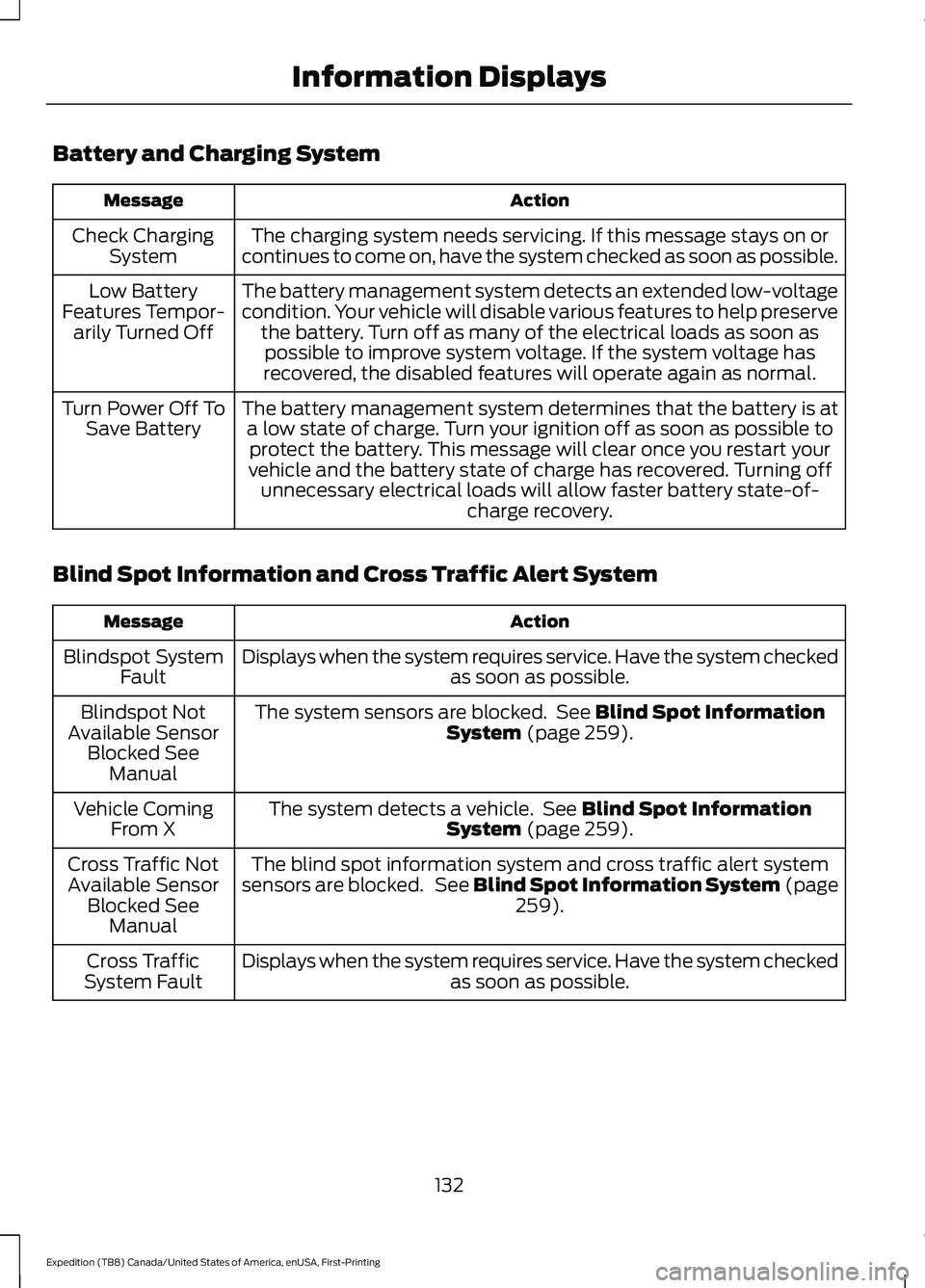
Battery and Charging System
Action
Message
The charging system needs servicing. If this message stays on or
continues to come on, have the system checked as soon as possible.
Check Charging
System
The battery management system detects an extended low-voltage
condition. Your vehicle will disable various features to help preservethe battery. Turn off as many of the electrical loads as soon aspossible to improve system voltage. If the system voltage has
recovered, the disabled features will operate again as normal.
Low Battery
Features Tempor- arily Turned Off
The battery management system determines that the battery is ata low state of charge. Turn your ignition off as soon as possible toprotect the battery. This message will clear once you restart your
vehicle and the battery state of charge has recovered. Turning off unnecessary electrical loads will allow faster battery state-of- charge recovery.
Turn Power Off To
Save Battery
Blind Spot Information and Cross Traffic Alert System Action
Message
Displays when the system requires service. Have the system checked as soon as possible.
Blindspot System
Fault
The system sensors are blocked. See Blind Spot Information
System (page 259).
Blindspot Not
Available Sensor Blocked See Manual
The system detects a vehicle. See
Blind Spot Information
System (page 259).
Vehicle Coming
From X
The blind spot information system and cross traffic alert system
sensors are blocked. See
Blind Spot Information System (page
259).
Cross Traffic Not
Available Sensor Blocked See Manual
Displays when the system requires service. Have the system checked as soon as possible.
Cross Traffic
System Fault
132
Expedition (TB8) Canada/United States of America, enUSA, First-Printing Information Displays
Page 143 of 574
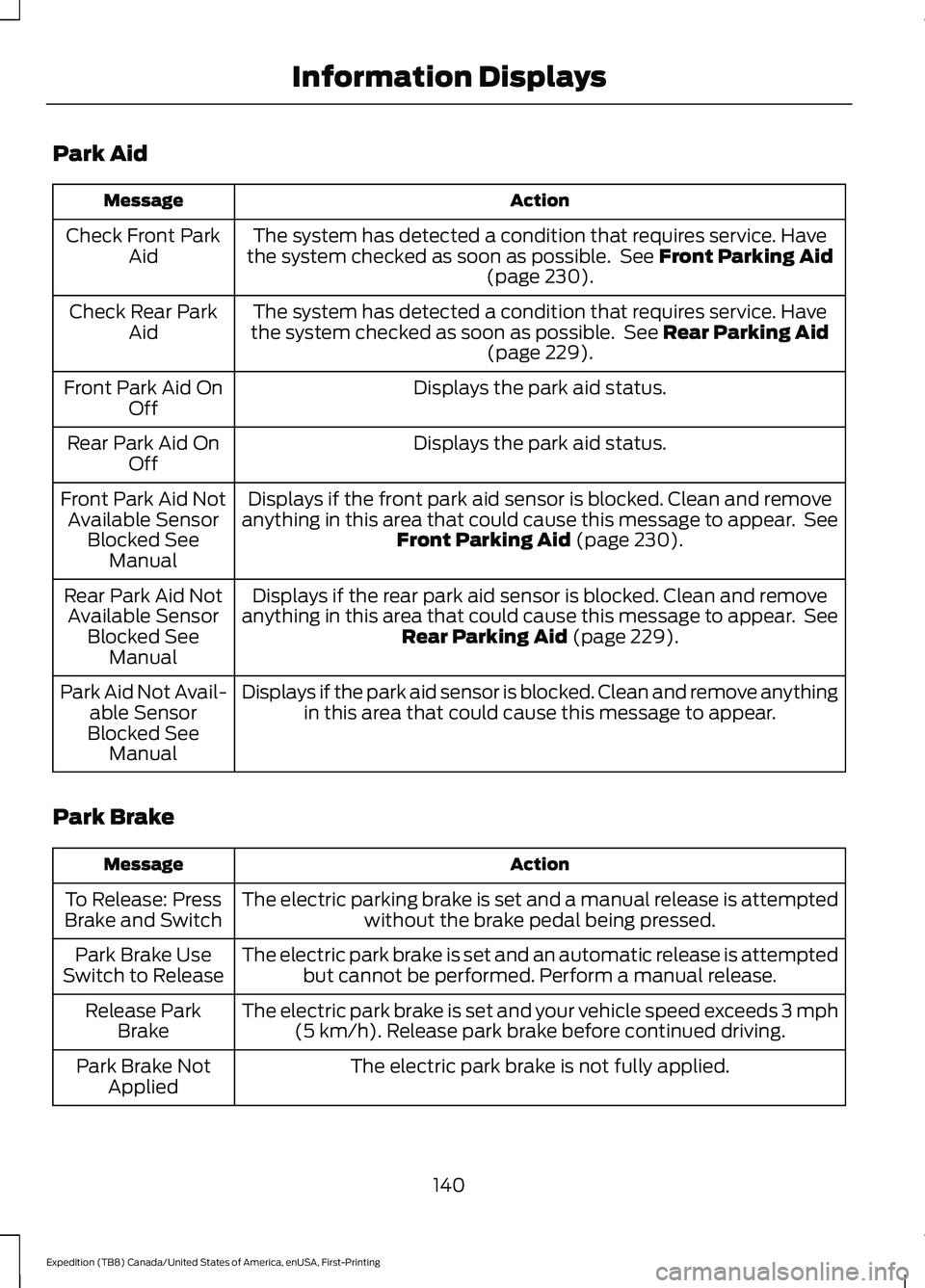
Park Aid
Action
Message
The system has detected a condition that requires service. Have
the system checked as soon as possible. See Front Parking Aid
(page 230).
Check Front Park
Aid
The system has detected a condition that requires service. Have
the system checked as soon as possible. See
Rear Parking Aid
(page 229).
Check Rear Park
Aid
Displays the park aid status.
Front Park Aid On
Off
Displays the park aid status.
Rear Park Aid On
Off
Displays if the front park aid sensor is blocked. Clean and remove
anything in this area that could cause this message to appear. See Front Parking Aid
(page 230).
Front Park Aid Not
Available Sensor Blocked See Manual
Displays if the rear park aid sensor is blocked. Clean and remove
anything in this area that could cause this message to appear. See Rear Parking Aid
(page 229).
Rear Park Aid Not
Available Sensor Blocked See Manual
Displays if the park aid sensor is blocked. Clean and remove anythingin this area that could cause this message to appear.
Park Aid Not Avail-
able Sensor
Blocked See Manual
Park Brake Action
Message
The electric parking brake is set and a manual release is attemptedwithout the brake pedal being pressed.
To Release: Press
Brake and Switch
The electric park brake is set and an automatic release is attemptedbut cannot be performed. Perform a manual release.
Park Brake Use
Switch to Release
The electric park brake is set and your vehicle speed exceeds 3 mph(5 km/h)
. Release park brake before continued driving.
Release Park
Brake
The electric park brake is not fully applied.
Park Brake Not
Applied
140
Expedition (TB8) Canada/United States of America, enUSA, First-Printing Information Displays
Page 144 of 574

Action
Message
The electric park brake is not fully released.
Park Brake Not
Released
The electric park brake system has been put into a special modethat is used to allow service of the rear brakes. Have the system checked as soon as possible.
Park Brake Main-
tenance Mode
The electric park brake system has detected a condition that
requires service. Some functionality may still be available. Have the system checked as soon as possible.
Park Brake Limited
Function Service Required
The electric park brake system has detected a condition that
requires service. Have the system checked as soon as possible.
Park Brake
Malfunction
Service Now
Power Steering Action
Message
The power steering system has detected a condition that requiresservice. Have the system checked as soon as possible.
Steering Fault
Service Now
The power steering system is not working. Stop your vehicle in asafe place. Have the system checked as soon as possible.
Steering Loss Stop
Safely
The power steering system has detected a condition within the
power steering system or passive entry or passive start system that requires service. Have the system checked as soon as possible.
Steering Assist
Fault Service Required
The steering lock system has detected a condition that requiresservice. Have the system checked as soon as possible.
Steering Lock
Malfunction
Service Now
Pre-Collision Assist Action
Message
You have a blocked sensor due to
inclement weather, ice, mud or water in
front of the radar sensor. You can typically clean the sensor to resolve.
Pre-Collision Assist Not Available Sensor
Blocked
Displays when the system requires service.Have the system checked as soon as possible.
Pre-Collision Assist Not Available
141
Expedition (TB8) Canada/United States of America, enUSA, First-Printing Information Displays
Page 147 of 574
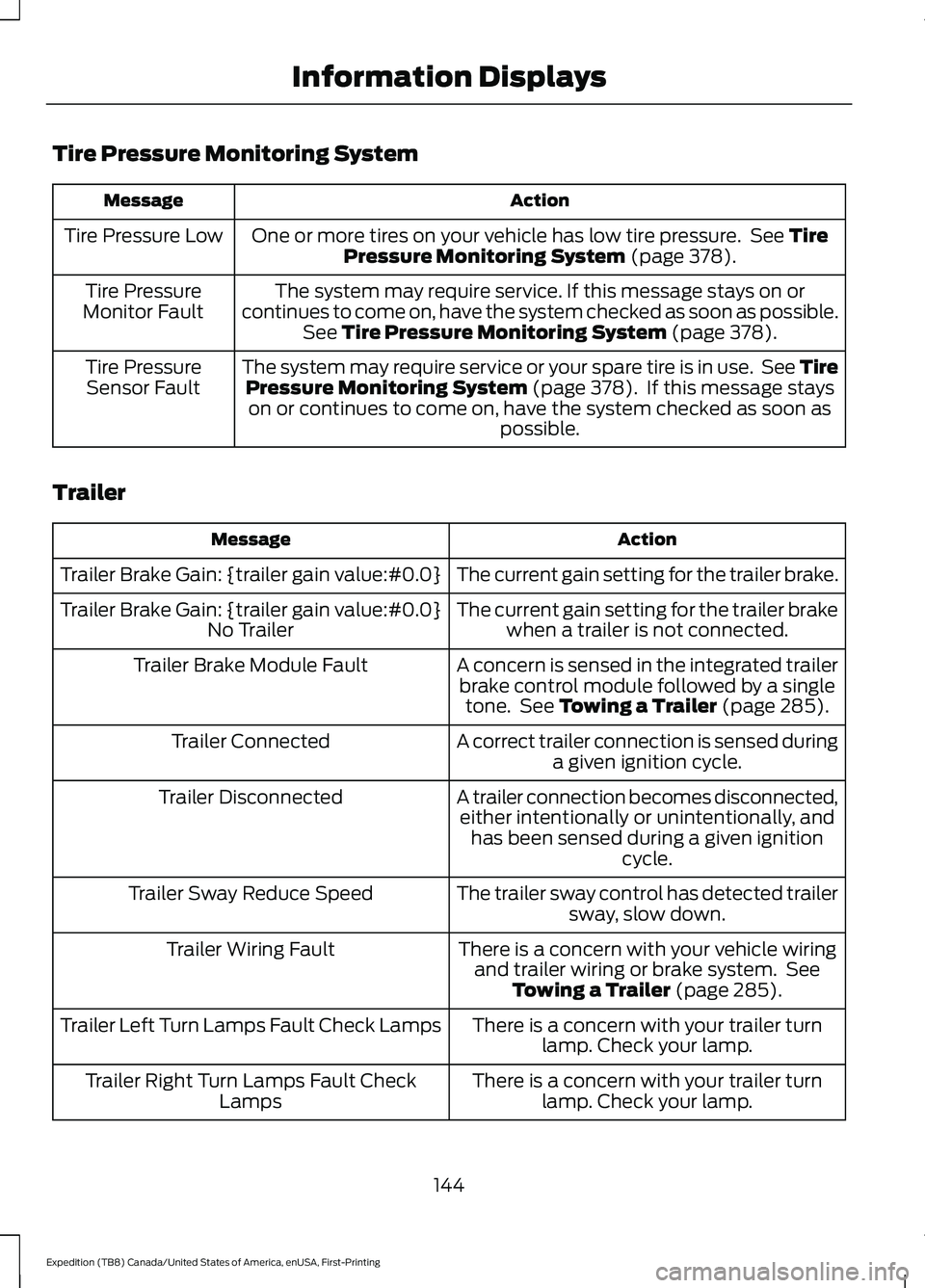
Tire Pressure Monitoring System
Action
Message
One or more tires on your vehicle has low tire pressure. See Tire
Pressure Monitoring System (page 378).
Tire Pressure Low
The system may require service. If this message stays on or
continues to come on, have the system checked as soon as possible. See
Tire Pressure Monitoring System (page 378).
Tire Pressure
Monitor Fault
The system may require service or your spare tire is in use. See TirePressure Monitoring System
(page 378). If this message stays
on or continues to come on, have the system checked as soon as possible.
Tire Pressure
Sensor Fault
Trailer Action
Message
The current gain setting for the trailer brake.
Trailer Brake Gain: {trailer gain value:#0.0}
The current gain setting for the trailer brakewhen a trailer is not connected.
Trailer Brake Gain: {trailer gain value:#0.0}
No Trailer
A concern is sensed in the integrated trailerbrake control module followed by a single tone. See
Towing a Trailer (page 285).
Trailer Brake Module Fault
A correct trailer connection is sensed duringa given ignition cycle.
Trailer Connected
A trailer connection becomes disconnected,either intentionally or unintentionally, and has been sensed during a given ignition cycle.
Trailer Disconnected
The trailer sway control has detected trailersway, slow down.
Trailer Sway Reduce Speed
There is a concern with your vehicle wiringand trailer wiring or brake system. See Towing a Trailer
(page 285).
Trailer Wiring Fault
There is a concern with your trailer turnlamp. Check your lamp.
Trailer Left Turn Lamps Fault Check Lamps
There is a concern with your trailer turnlamp. Check your lamp.
Trailer Right Turn Lamps Fault Check
Lamps
144
Expedition (TB8) Canada/United States of America, enUSA, First-Printing Information Displays
Page 148 of 574
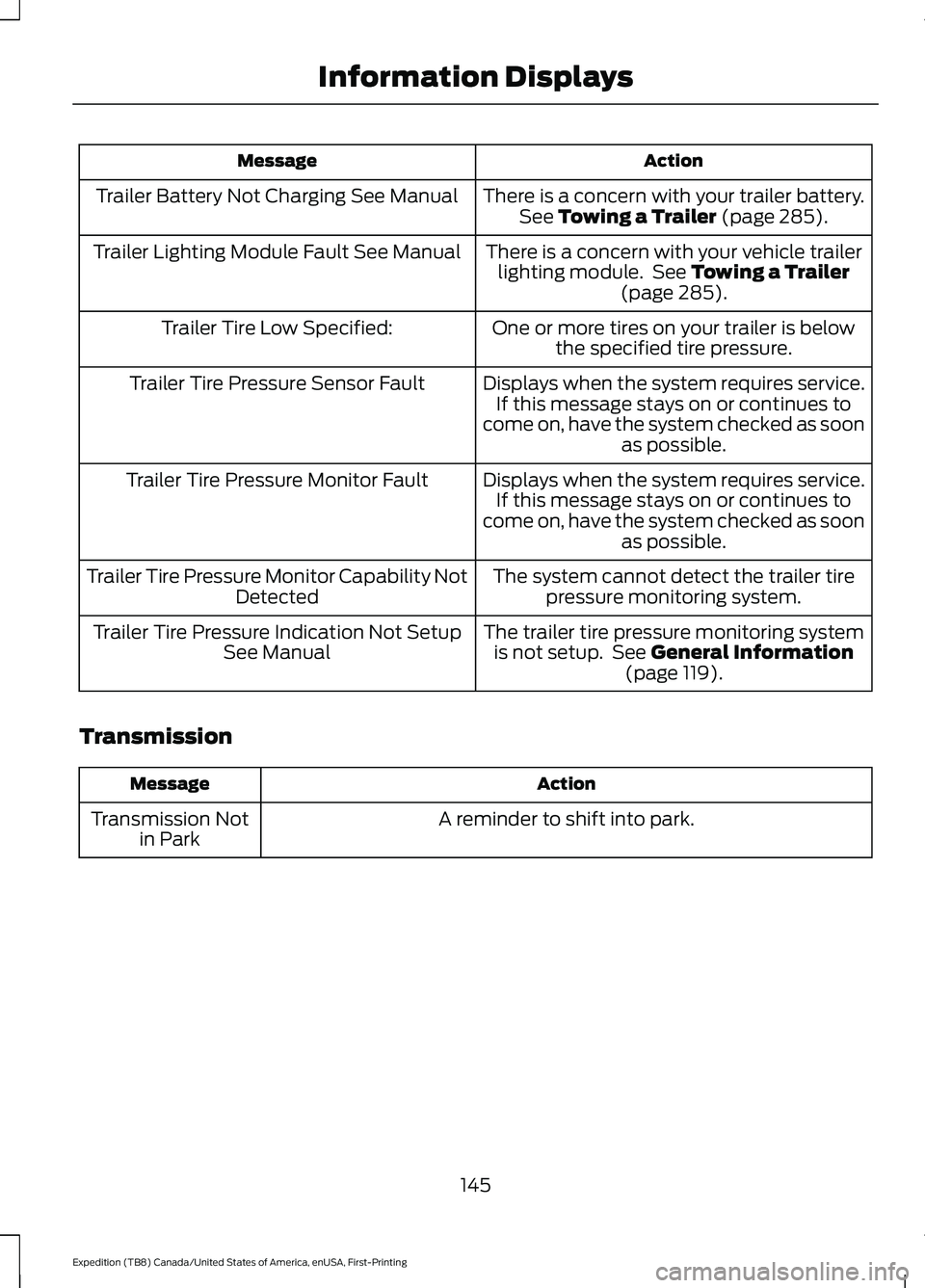
Action
Message
There is a concern with your trailer battery.See Towing a Trailer (page 285).
Trailer Battery Not Charging See Manual
There is a concern with your vehicle trailerlighting module. See
Towing a Trailer
(page 285).
Trailer Lighting Module Fault See Manual
One or more tires on your trailer is belowthe specified tire pressure.
Trailer Tire Low Specified:
Displays when the system requires service.If this message stays on or continues to
come on, have the system checked as soon as possible.
Trailer Tire Pressure Sensor Fault
Displays when the system requires service.If this message stays on or continues to
come on, have the system checked as soon as possible.
Trailer Tire Pressure Monitor Fault
The system cannot detect the trailer tirepressure monitoring system.
Trailer Tire Pressure Monitor Capability Not
Detected
The trailer tire pressure monitoring systemis not setup. See
General Information
(page 119).
Trailer Tire Pressure Indication Not Setup
See Manual
Transmission Action
Message
A reminder to shift into park.
Transmission Not
in Park
145
Expedition (TB8) Canada/United States of America, enUSA, First-Printing Information Displays
Page 202 of 574
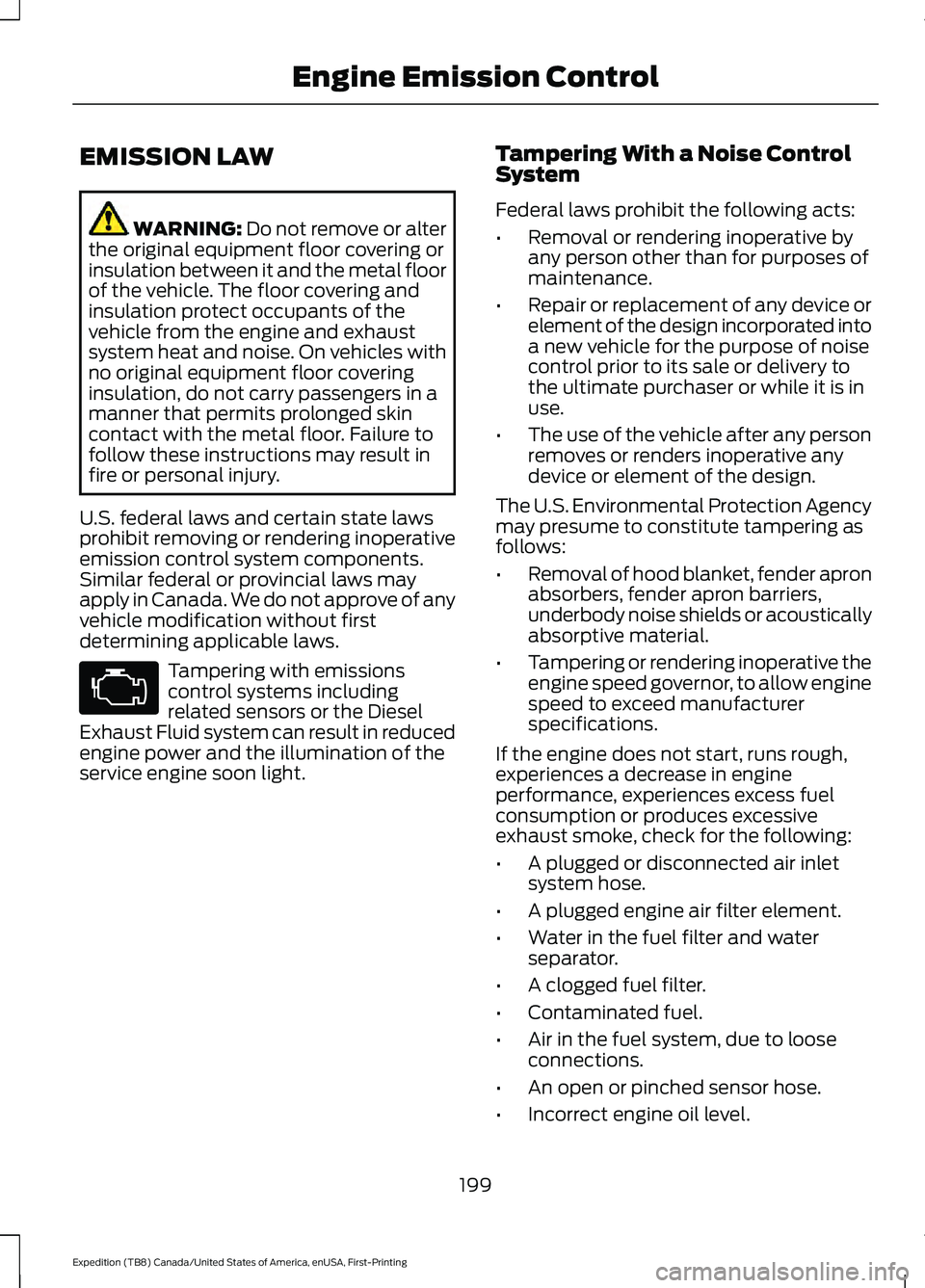
EMISSION LAW
WARNING: Do not remove or alter
the original equipment floor covering or
insulation between it and the metal floor
of the vehicle. The floor covering and
insulation protect occupants of the
vehicle from the engine and exhaust
system heat and noise. On vehicles with
no original equipment floor covering
insulation, do not carry passengers in a
manner that permits prolonged skin
contact with the metal floor. Failure to
follow these instructions may result in
fire or personal injury.
U.S. federal laws and certain state laws
prohibit removing or rendering inoperative
emission control system components.
Similar federal or provincial laws may
apply in Canada. We do not approve of any
vehicle modification without first
determining applicable laws. Tampering with emissions
control systems including
related sensors or the Diesel
Exhaust Fluid system can result in reduced
engine power and the illumination of the
service engine soon light. Tampering With a Noise Control
System
Federal laws prohibit the following acts:
•
Removal or rendering inoperative by
any person other than for purposes of
maintenance.
• Repair or replacement of any device or
element of the design incorporated into
a new vehicle for the purpose of noise
control prior to its sale or delivery to
the ultimate purchaser or while it is in
use.
• The use of the vehicle after any person
removes or renders inoperative any
device or element of the design.
The U.S. Environmental Protection Agency
may presume to constitute tampering as
follows:
• Removal of hood blanket, fender apron
absorbers, fender apron barriers,
underbody noise shields or acoustically
absorptive material.
• Tampering or rendering inoperative the
engine speed governor, to allow engine
speed to exceed manufacturer
specifications.
If the engine does not start, runs rough,
experiences a decrease in engine
performance, experiences excess fuel
consumption or produces excessive
exhaust smoke, check for the following:
• A plugged or disconnected air inlet
system hose.
• A plugged engine air filter element.
• Water in the fuel filter and water
separator.
• A clogged fuel filter.
• Contaminated fuel.
• Air in the fuel system, due to loose
connections.
• An open or pinched sensor hose.
• Incorrect engine oil level.
199
Expedition (TB8) Canada/United States of America, enUSA, First-Printing Engine Emission Control
Page 214 of 574
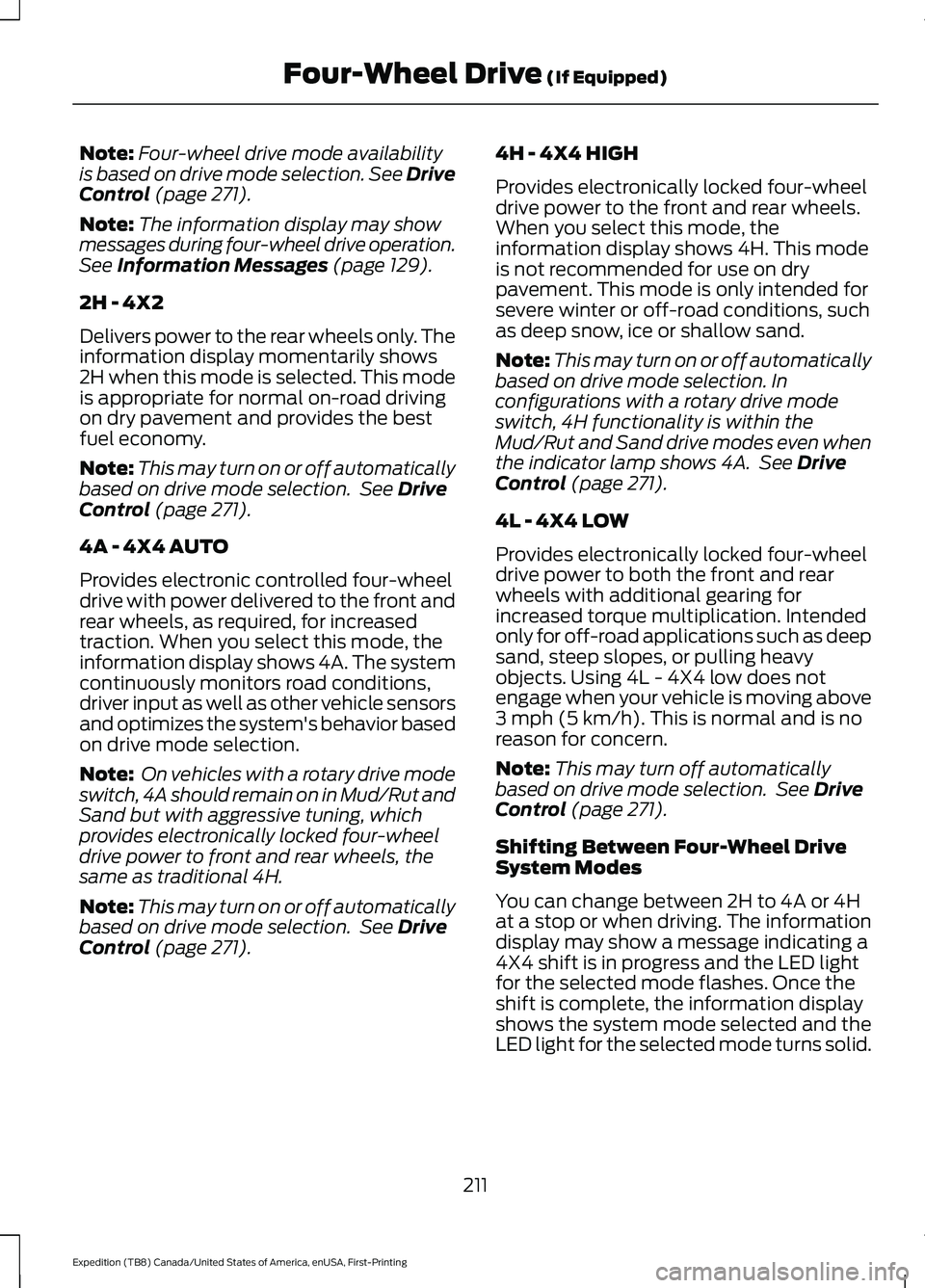
Note:
Four-wheel drive mode availability
is based on drive mode selection. See Drive
Control (page 271).
Note: The information display may show
messages during four-wheel drive operation.
See
Information Messages (page 129).
2H - 4X2
Delivers power to the rear wheels only. The
information display momentarily shows
2H when this mode is selected. This mode
is appropriate for normal on-road driving
on dry pavement and provides the best
fuel economy.
Note: This may turn on or off automatically
based on drive mode selection. See
Drive
Control (page 271).
4A - 4X4 AUTO
Provides electronic controlled four-wheel
drive with power delivered to the front and
rear wheels, as required, for increased
traction. When you select this mode, the
information display shows 4A. The system
continuously monitors road conditions,
driver input as well as other vehicle sensors
and optimizes the system's behavior based
on drive mode selection.
Note: On vehicles with a rotary drive mode
switch, 4A should remain on in Mud/Rut and
Sand but with aggressive tuning, which
provides electronically locked four-wheel
drive power to front and rear wheels, the
same as traditional 4H.
Note: This may turn on or off automatically
based on drive mode selection. See
Drive
Control (page 271). 4H - 4X4 HIGH
Provides electronically locked four-wheel
drive power to the front and rear wheels.
When you select this mode, the
information display shows 4H. This mode
is not recommended for use on dry
pavement. This mode is only intended for
severe winter or off-road conditions, such
as deep snow, ice or shallow sand.
Note:
This may turn on or off automatically
based on drive mode selection. In
configurations with a rotary drive mode
switch, 4H functionality is within the
Mud/Rut and Sand drive modes even when
the indicator lamp shows 4A. See
Drive
Control (page 271).
4L - 4X4 LOW
Provides electronically locked four-wheel
drive power to both the front and rear
wheels with additional gearing for
increased torque multiplication. Intended
only for off-road applications such as deep
sand, steep slopes, or pulling heavy
objects. Using 4L - 4X4 low does not
engage when your vehicle is moving above
3 mph (5 km/h)
. This is normal and is no
reason for concern.
Note: This may turn off automatically
based on drive mode selection. See
Drive
Control (page 271).
Shifting Between Four-Wheel Drive
System Modes
You can change between 2H to 4A or 4H
at a stop or when driving. The information
display may show a message indicating a
4X4 shift is in progress and the LED light
for the selected mode flashes. Once the
shift is complete, the information display
shows the system mode selected and the
LED light for the selected mode turns solid.
211
Expedition (TB8) Canada/United States of America, enUSA, First-Printing Four-Wheel Drive
(If Equipped)
Page 225 of 574
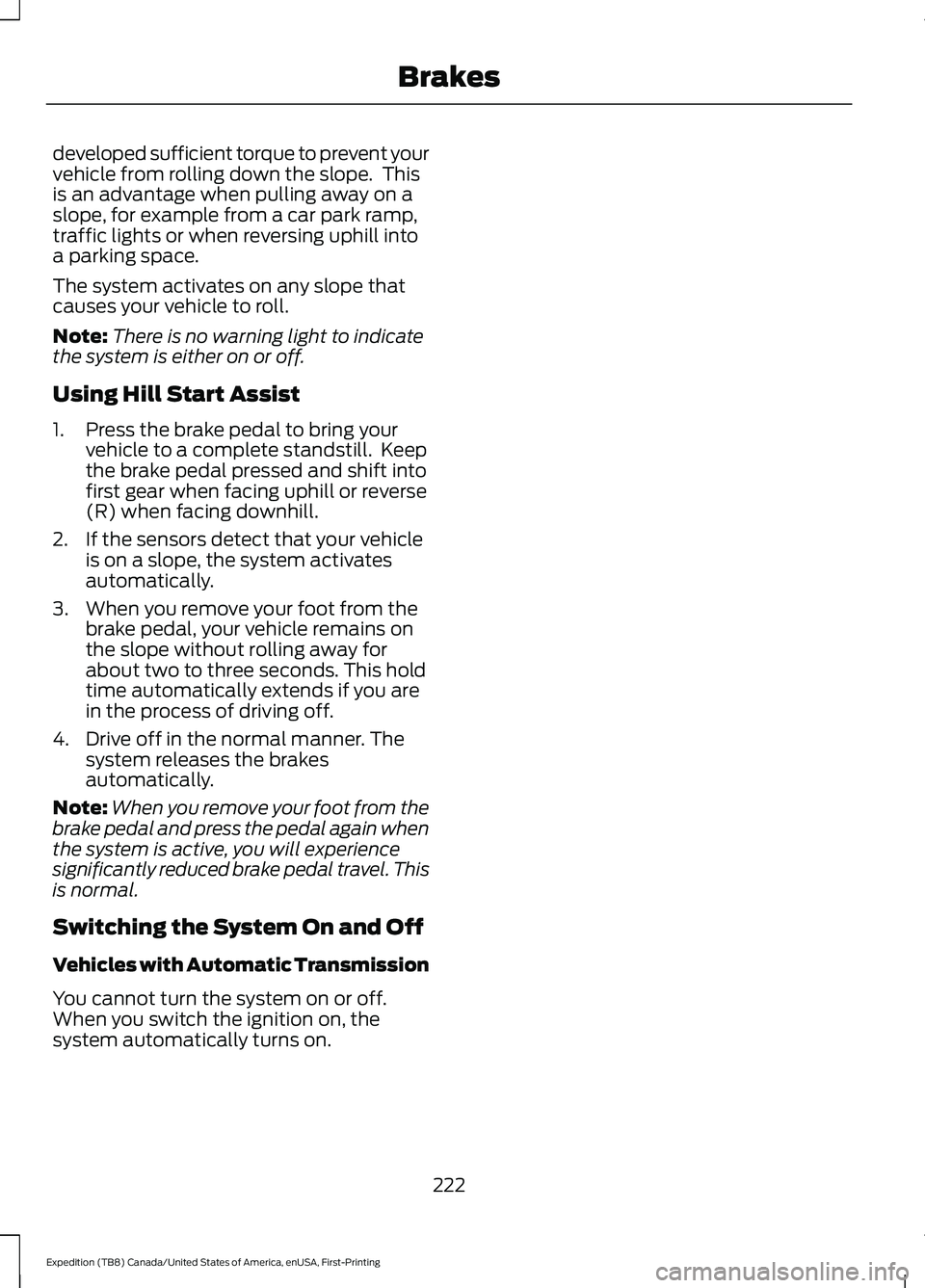
developed sufficient torque to prevent your
vehicle from rolling down the slope. This
is an advantage when pulling away on a
slope, for example from a car park ramp,
traffic lights or when reversing uphill into
a parking space.
The system activates on any slope that
causes your vehicle to roll.
Note:
There is no warning light to indicate
the system is either on or off.
Using Hill Start Assist
1. Press the brake pedal to bring your vehicle to a complete standstill. Keep
the brake pedal pressed and shift into
first gear when facing uphill or reverse
(R) when facing downhill.
2. If the sensors detect that your vehicle is on a slope, the system activates
automatically.
3. When you remove your foot from the brake pedal, your vehicle remains on
the slope without rolling away for
about two to three seconds. This hold
time automatically extends if you are
in the process of driving off.
4. Drive off in the normal manner. The system releases the brakes
automatically.
Note: When you remove your foot from the
brake pedal and press the pedal again when
the system is active, you will experience
significantly reduced brake pedal travel. This
is normal.
Switching the System On and Off
Vehicles with Automatic Transmission
You cannot turn the system on or off.
When you switch the ignition on, the
system automatically turns on.
222
Expedition (TB8) Canada/United States of America, enUSA, First-Printing Brakes
Page 227 of 574
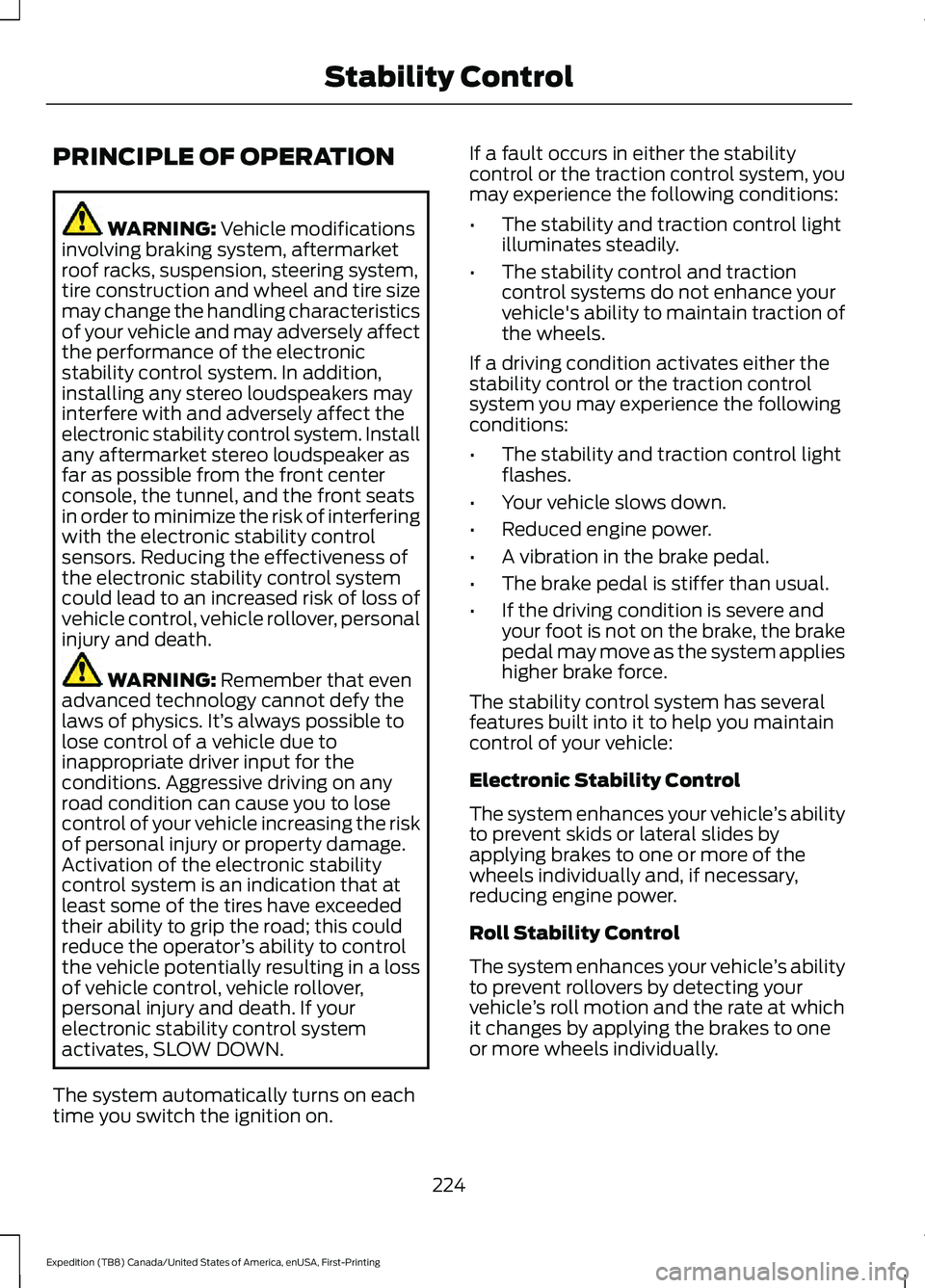
PRINCIPLE OF OPERATION
WARNING: Vehicle modifications
involving braking system, aftermarket
roof racks, suspension, steering system,
tire construction and wheel and tire size
may change the handling characteristics
of your vehicle and may adversely affect
the performance of the electronic
stability control system. In addition,
installing any stereo loudspeakers may
interfere with and adversely affect the
electronic stability control system. Install
any aftermarket stereo loudspeaker as
far as possible from the front center
console, the tunnel, and the front seats
in order to minimize the risk of interfering
with the electronic stability control
sensors. Reducing the effectiveness of
the electronic stability control system
could lead to an increased risk of loss of
vehicle control, vehicle rollover, personal
injury and death. WARNING:
Remember that even
advanced technology cannot defy the
laws of physics. It’ s always possible to
lose control of a vehicle due to
inappropriate driver input for the
conditions. Aggressive driving on any
road condition can cause you to lose
control of your vehicle increasing the risk
of personal injury or property damage.
Activation of the electronic stability
control system is an indication that at
least some of the tires have exceeded
their ability to grip the road; this could
reduce the operator ’s ability to control
the vehicle potentially resulting in a loss
of vehicle control, vehicle rollover,
personal injury and death. If your
electronic stability control system
activates, SLOW DOWN.
The system automatically turns on each
time you switch the ignition on. If a fault occurs in either the stability
control or the traction control system, you
may experience the following conditions:
•
The stability and traction control light
illuminates steadily.
• The stability control and traction
control systems do not enhance your
vehicle's ability to maintain traction of
the wheels.
If a driving condition activates either the
stability control or the traction control
system you may experience the following
conditions:
• The stability and traction control light
flashes.
• Your vehicle slows down.
• Reduced engine power.
• A vibration in the brake pedal.
• The brake pedal is stiffer than usual.
• If the driving condition is severe and
your foot is not on the brake, the brake
pedal may move as the system applies
higher brake force.
The stability control system has several
features built into it to help you maintain
control of your vehicle:
Electronic Stability Control
The system enhances your vehicle ’s ability
to prevent skids or lateral slides by
applying brakes to one or more of the
wheels individually and, if necessary,
reducing engine power.
Roll Stability Control
The system enhances your vehicle ’s ability
to prevent rollovers by detecting your
vehicle ’s roll motion and the rate at which
it changes by applying the brakes to one
or more wheels individually.
224
Expedition (TB8) Canada/United States of America, enUSA, First-Printing Stability Control
Page 231 of 574
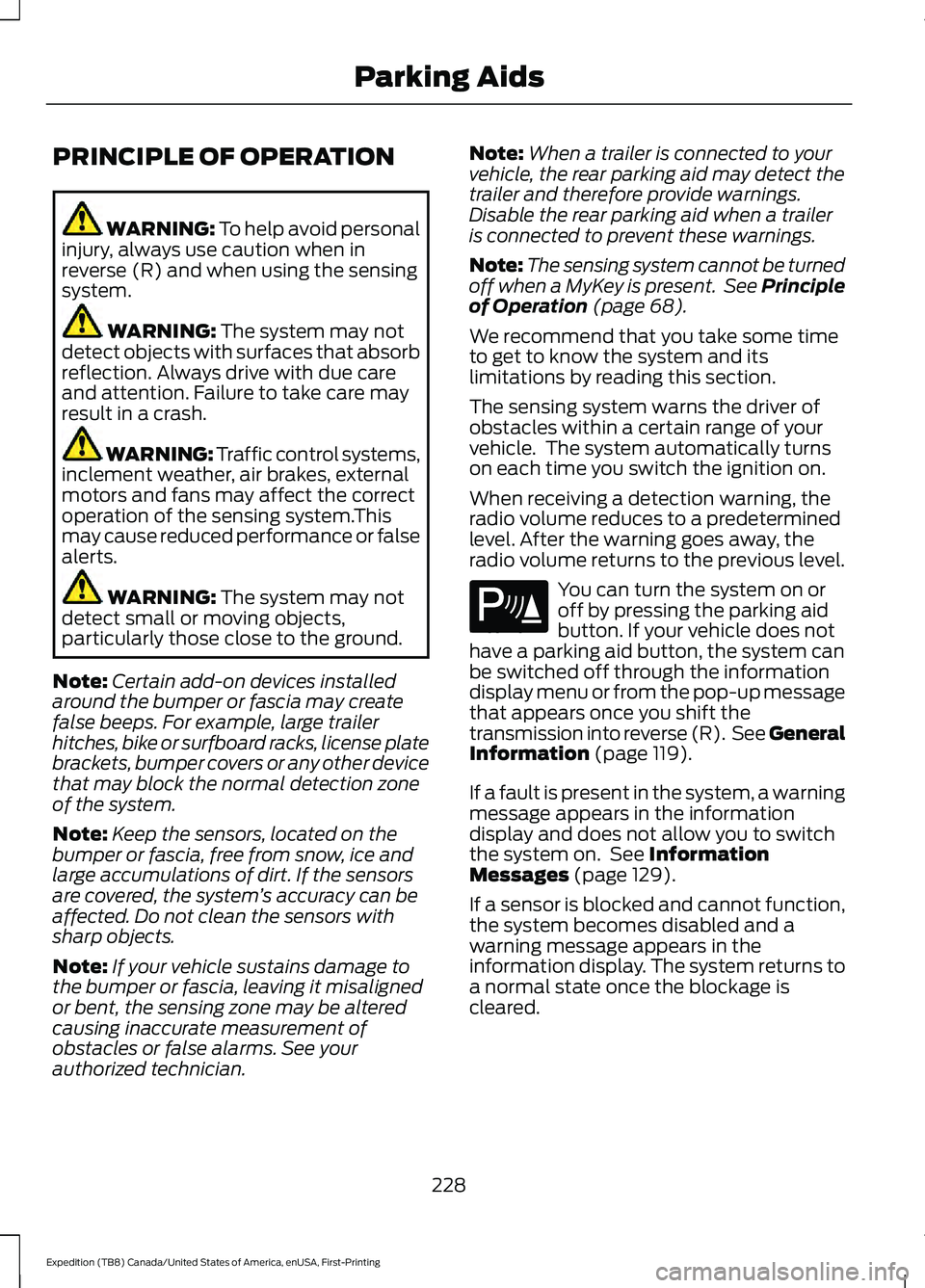
PRINCIPLE OF OPERATION
WARNING: To help avoid personal
injury, always use caution when in
reverse (R) and when using the sensing
system. WARNING:
The system may not
detect objects with surfaces that absorb
reflection. Always drive with due care
and attention. Failure to take care may
result in a crash. WARNING: Traffic control systems,
inclement weather, air brakes, external
motors and fans may affect the correct
operation of the sensing system.This
may cause reduced performance or false
alerts. WARNING:
The system may not
detect small or moving objects,
particularly those close to the ground.
Note: Certain add-on devices installed
around the bumper or fascia may create
false beeps. For example, large trailer
hitches, bike or surfboard racks, license plate
brackets, bumper covers or any other device
that may block the normal detection zone
of the system.
Note: Keep the sensors, located on the
bumper or fascia, free from snow, ice and
large accumulations of dirt. If the sensors
are covered, the system ’s accuracy can be
affected. Do not clean the sensors with
sharp objects.
Note: If your vehicle sustains damage to
the bumper or fascia, leaving it misaligned
or bent, the sensing zone may be altered
causing inaccurate measurement of
obstacles or false alarms. See your
authorized technician. Note:
When a trailer is connected to your
vehicle, the rear parking aid may detect the
trailer and therefore provide warnings.
Disable the rear parking aid when a trailer
is connected to prevent these warnings.
Note: The sensing system cannot be turned
off when a MyKey is present. See Principle
of Operation
(page 68).
We recommend that you take some time
to get to know the system and its
limitations by reading this section.
The sensing system warns the driver of
obstacles within a certain range of your
vehicle. The system automatically turns
on each time you switch the ignition on.
When receiving a detection warning, the
radio volume reduces to a predetermined
level. After the warning goes away, the
radio volume returns to the previous level. You can turn the system on or
off by pressing the parking aid
button. If your vehicle does not
have a parking aid button, the system can
be switched off through the information
display menu or from the pop-up message
that appears once you shift the
transmission into reverse (R). See General
Information
(page 119).
If a fault is present in the system, a warning
message appears in the information
display and does not allow you to switch
the system on. See
Information
Messages (page 129).
If a sensor is blocked and cannot function,
the system becomes disabled and a
warning message appears in the
information display. The system returns to
a normal state once the blockage is
cleared.
228
Expedition (TB8) Canada/United States of America, enUSA, First-Printing Parking AidsE139213